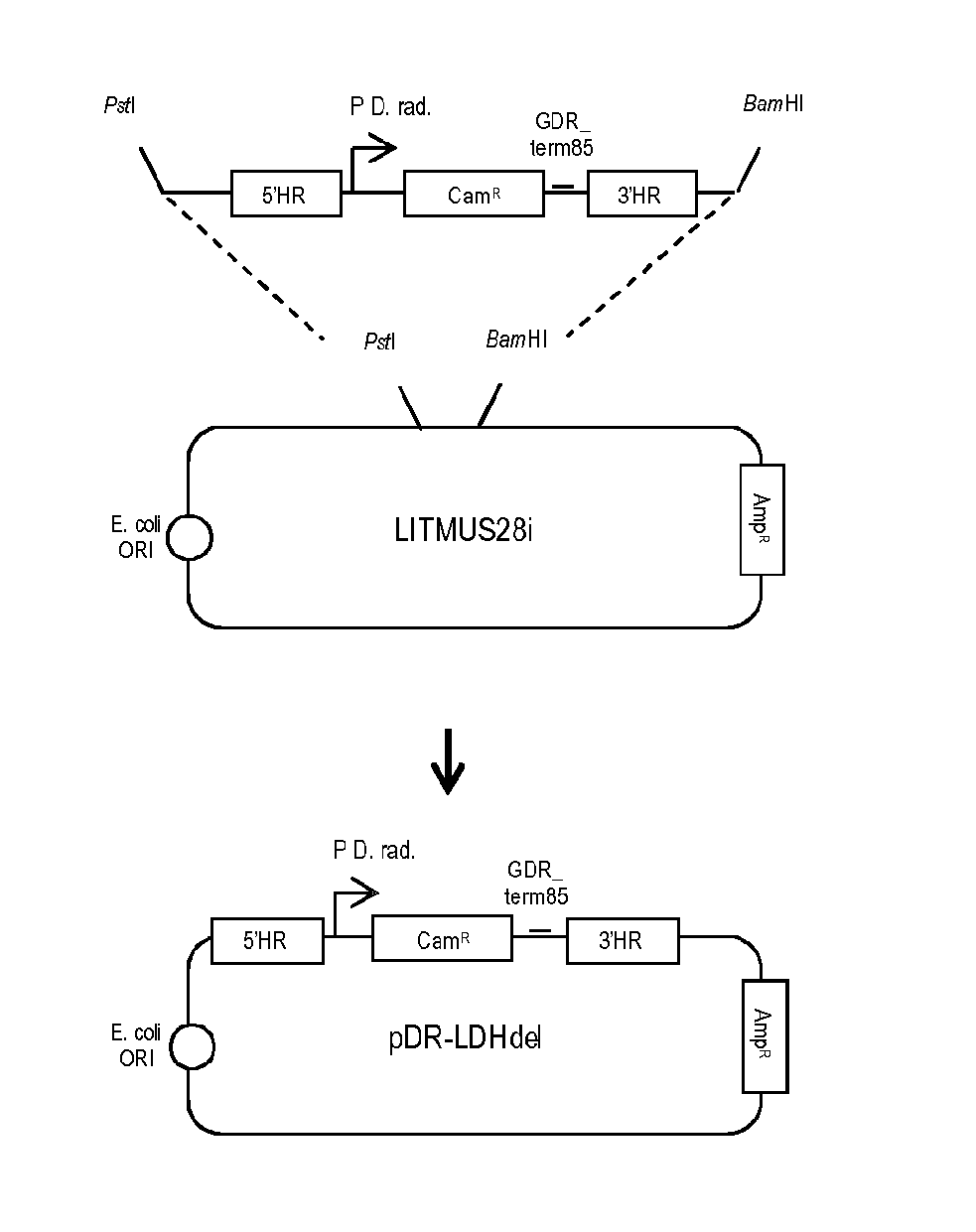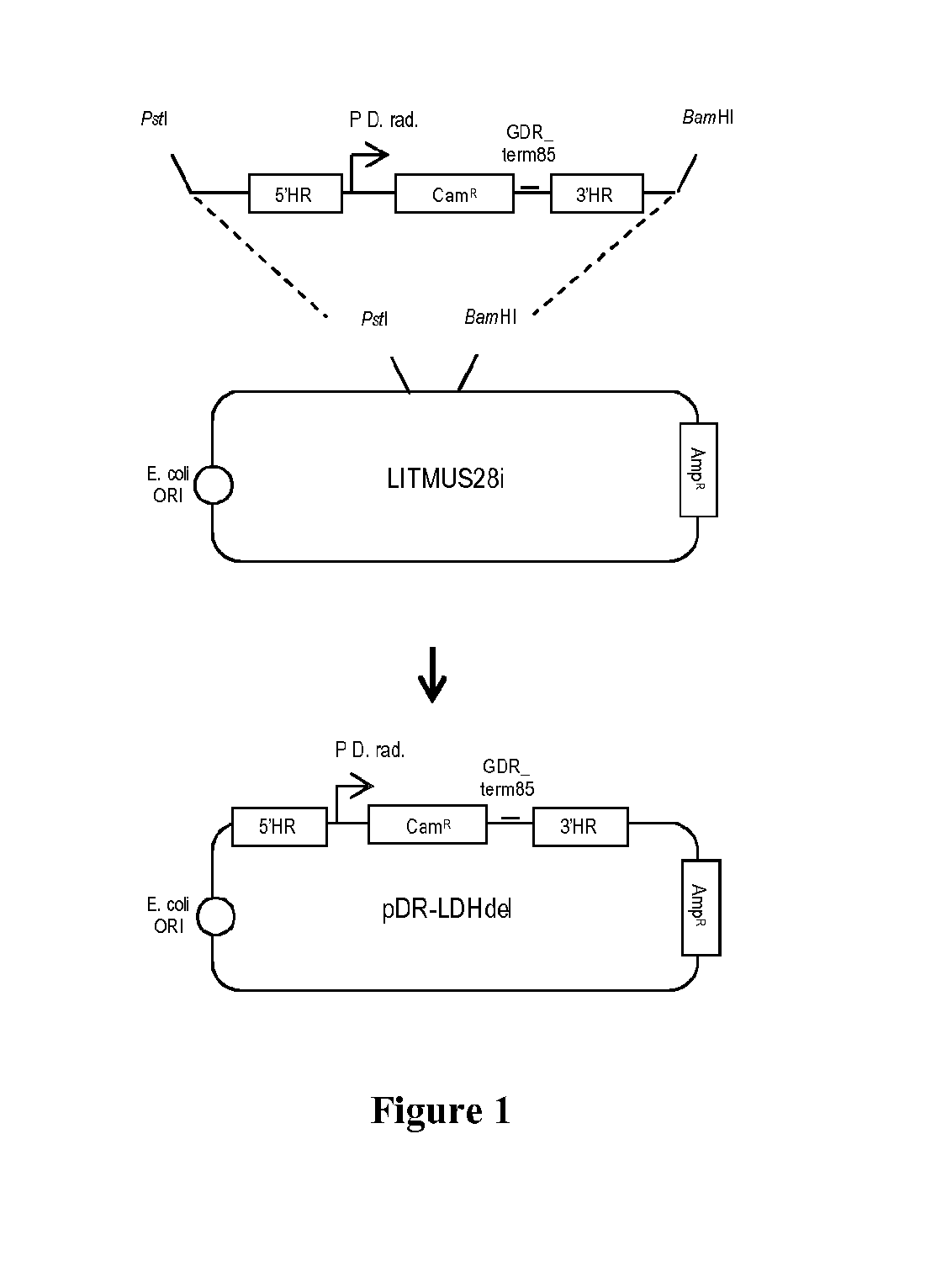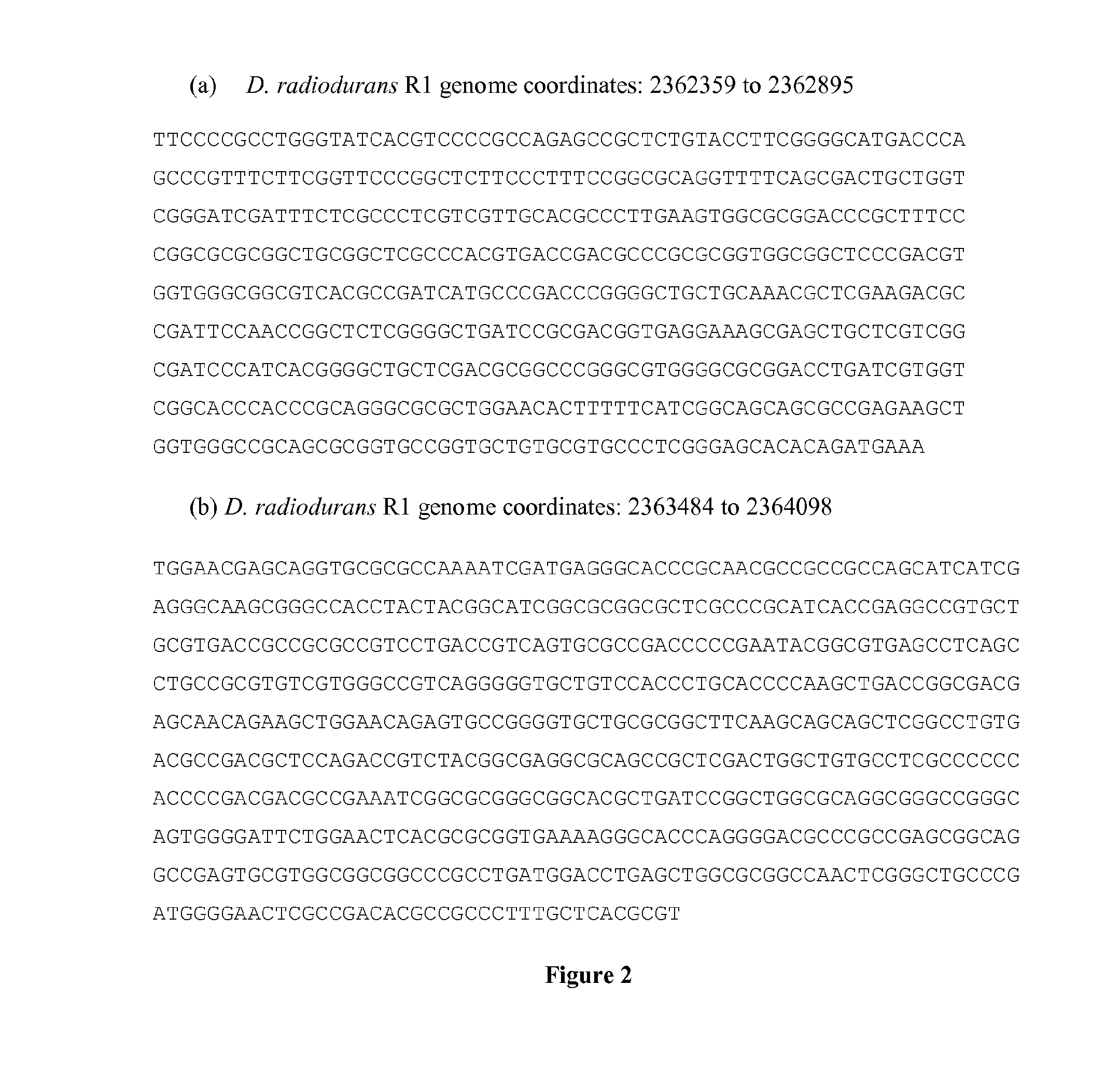Recombinant bacteria and the uses thereof for producing ethanol
a technology of ethanol and recombinant bacteria, which is applied in the direction of lyase, carbon-carbon lyase, enzymology, etc., can solve the problems of substantial drawback for industrial use, no satisfactory metabolite production of these strains, and the production of spores of geobacillus /i>strains
- Summary
- Abstract
- Description
- Claims
- Application Information
AI Technical Summary
Benefits of technology
Problems solved by technology
Method used
Image
Examples
example 1
Deinococcus radiodurans R1L-Lactate Dehydrogenase (LDH) Deletion
[0114]LDH— mutants of the wild type Deinococcus radiodurans R1 (D. radiodurans) were produced as follows.
a. Construct for LDH Deletion (pDR-LDHde1)
[0115]We created a new construct named pDR-LDHde1 for the partial deletion of the LDH gene (DR—2364) in wild type D. radiodurans (see FIG. 1). For this, we used the LITMUS28i backbone which is replicative in E. coli but not in D. radiodurans. A synthesized DNA insert was cloned in LITMUS28i; this insert is made of a chloramphenicol resistance (CamR) cassette (1344 nucleotides) and of 5′ and 3′ flanking homologous regions (537 nucleotides and 615 nucleotides) placed respectively upstream and downstream of this cassette (FIG. 2). The pDR-LDHde1 construct was built to replace 589 nucleotides of LDH gene (some of the 589 nucleotides encoding for residues involved in catalysis) by the CamR cassette.
b. Creation of LDH Deficient Mutants
[0116]D. radiodurans wild type was transformed ...
example 2
Pyruvate Decarboxylase and Alcohol Dehydrogenase Production in D. radiodurans
[0118]D. radiodurans strains producing pyruvate decarboxylase (ZmPDC) and alcohol dehydrogenase (ZmADH) from Zymomonas mobilis were created as follows.
[0119]a. Creation of Constructs Carrying Genes for Ethanol Production
[0120]Four constructs were created in order to produce ethanol in D. radiodurans cells (see FIG. 2).
[0121]For the first construct named pI3-DR-P-PDC-ADH, the pyruvate decarboxylase gene (ZmPDC, ZMO1360) and the alcohol dehydrogenase II gene (ZmADH, ZMO1596) from Zymomonas mobilis subsp. Mobilis ZM4 (FIG. 4) were placed in operon and cloned into BamHI and SalI of the D. radiodurans replicative pI3 plasmid (Masters and Minton, 1992) (see FIG. 5). pI3 vector confers chloramphenicol resistance in D. radiodurans. A region of 432 base pairs located upstream of the translationnal start codon of the elongation factor TU tufA (DR—0309) and containing a promoter activity (Lecointe et al, 2004) was pl...
example 3
Creation of Integrative Deinococcus radiodurans LDH-Mutants Producing ZmPDC and ZmADH
[0125]589 nucleotides of the LDH gene (DR—2364) were replaced in wild type D. radiodurans by a chloramphenicol resistance cassette followed by ZmPDC and ZmADH genes respectively under the control of PtufA and PtufB promoters.
[0126]In order to create this PDC+ADH+LDH— mutant, the 3 following nucleotidic sequences were amplified by PCR:[0127]the 5′ flanking homologous region followed by a chloramphenicol resistance cassette were amplified with primers EG31F and EG32R (see list below) using pDR-LDHde1 as a template[0128]P-PDC-P-ADH sequence was amplified with primers EG33F and EG34R (see list below) using pI3-P-PDC-P-ADH as a template[0129]the 3′ flanking homologous region was amplified with primers EG35F and EG36R (see list below) using pDR-LDHde1 as a template
List of Primers:
[0130]
EG31FSEQ ID NO: 55′-TTCCCCGCCTGGGTATCACGTC-3′EG32RSEQ ID NO: 65′-CTCGGATCCTTCACAGTTCTCCGCCCCCTCC-3′EG33FSEQ ID NO: 75′-GA...
PUM
| Property | Measurement | Unit |
|---|---|---|
| Temperature | aaaaa | aaaaa |
| Volume | aaaaa | aaaaa |
| Volume | aaaaa | aaaaa |
Abstract
Description
Claims
Application Information
 Login to View More
Login to View More - Generate Ideas
- Intellectual Property
- Life Sciences
- Materials
- Tech Scout
- Unparalleled Data Quality
- Higher Quality Content
- 60% Fewer Hallucinations
Browse by: Latest US Patents, China's latest patents, Technical Efficacy Thesaurus, Application Domain, Technology Topic, Popular Technical Reports.
© 2025 PatSnap. All rights reserved.Legal|Privacy policy|Modern Slavery Act Transparency Statement|Sitemap|About US| Contact US: help@patsnap.com



